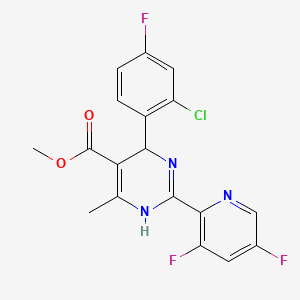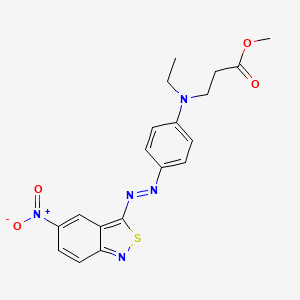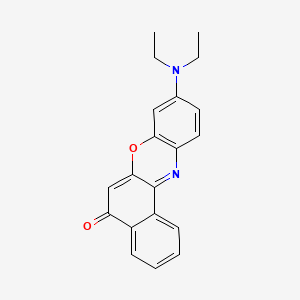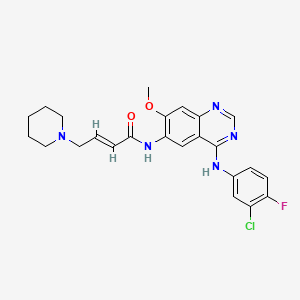
ダコミチニブ
概要
説明
ダコチニブは、非小細胞肺がん(NSCLC)の治療に主に使用される薬物です。ビジンプロという商品名で販売されています。 ダコチニブは、EGFR/HER1、HER2、HER4を含む上皮成長因子受容体(EGFR)ファミリーの選択的かつ不可逆的な阻害剤です 。ファイザー社によって開発され、 2018年9月にFDAによって承認されました .
科学的研究の応用
Dacomitinib has several scientific research applications, particularly in the fields of chemistry, biology, medicine, and industry :
Chemistry: Used as a model compound for studying the synthesis and reactions of quinazoline derivatives.
Biology: Investigated for its effects on cellular signaling pathways and its role in inhibiting the EGFR family.
Medicine: Primarily used for the treatment of NSCLC with EGFR mutations.
Industry: Employed in the development of new pharmaceutical formulations and drug delivery systems.
作用機序
生化学分析
Biochemical Properties
Dacomitinib interacts with the epidermal growth factor receptor (EGFR) family kinase domains . It binds irreversibly at the ATP domain of these receptors, inhibiting their activity . The major circulating metabolite of Dacomitinib is an O-desmethyl dacomitinib form named PF-05199265 .
Cellular Effects
Dacomitinib has shown to have significant effects on various types of cells, particularly cancer cells. It blocks proteins on cancer cells that encourage the cancer to grow . These proteins are called epidermal growth factor receptors (EGFR). If a cancer has these receptors, it is EGFR positive . Dacomitinib also increases the inhibition of the EGFR kinase domain as well as the activity in cell lines harboring resistance mutations such as T790M .
Molecular Mechanism
Dacomitinib works by selectively and irreversibly binding to the kinase domains EGFR/HER1, HER2, and HER4 . This inhibits tyrosine kinase autophosphorylation, resulting in a reduction of tumor growth and tumor regression .
Temporal Effects in Laboratory Settings
In laboratory settings, the effects of Dacomitinib have been observed over time. For instance, a study showed that Dacomitinib showed good activity and manageable toxicity in NSCLC patients with uncommon EGFR mutations .
Dosage Effects in Animal Models
In animal studies, Dacomitinib has shown to induce embryo-fetal toxicity, as demonstrated by an increased incidence of a post-implantation loss and reduced fetal body weight at doses resulting in exposures near the exposure at the 45mg human dose .
Metabolic Pathways
Dacomitinib undergoes oxidative and conjugative metabolism, marked mainly by the activity of glutathione and cytochrome P450 enzymes . After metabolism, its major circulating metabolite is an O-desmethyl dacomitinib form named PF-05199265 .
Transport and Distribution
Dacomitinib is absorbed and distributed in the body, and this process does not seem to be affected by food or the consumption of antacids . The peak plasma concentration after a dosage of 45 mg for 4 days is of 104 ng/ml .
Subcellular Localization
As Dacomitinib binds to these receptors, it is likely to be localized at the cell membrane where these receptors are present .
準備方法
ダコチニブの調製には、いくつかの合成経路と反応条件が伴います。 一方法は、以下の手順を含みます :
メトキシル化反応: N-(3-クロロ-4-フルオロフェニル)-7-フルオロ-6-ニトロ-4-キナゾリンアミンは、アルカリ/メタノール系でメトキシル化されて、N-(3-クロロ-4-フルオロフェニル)-7-メトキシ-6-ニトロキナゾリンアミン-4-アミンが得られます。
還元反応: メトキシル化反応で得られた化合物は、次にヒドラジン水和物を使用して還元され、N-(3-クロロ-4-フルオロフェニル)-7-メトキシル-6-アミノキナゾリン-4-アミンが得られます。
縮合反応: この化合物は、次にアシルクロリド化合物(2E)-4-(1-ピペリジル)-2-ブテン酸塩酸塩とN-メチルピロリドン溶媒中で縮合させて、粗生成物が得られます。
再結晶: 粗生成物は、エタノール-水溶液中で精製されて、ダコチニブが得られます。
化学反応の分析
ダコチニブは、酸化、還元、置換など、いくつかのタイプの化学反応を受けます 。これらの反応で使用される一般的な試薬と条件には以下が含まれます。
酸化: 過酸化水素や過マンガン酸カリウムなどの酸化剤の使用が含まれます。
還元: 一般的にヒドラジン水和物などの還元剤を使用します。
置換: 様々なハロゲン化剤と求核剤を使用します。
これらの反応で生成される主な生成物には、シトクロムP450酵素による酸化代謝を通じて形成される代謝産物であるO-デスメチルダコチニブが含まれます .
科学研究への応用
類似化合物との比較
ダコチニブは、アファチニブやゲフィチニブなどの他のEGFR阻害剤と比較されることがよくあります 。比較の重要な点を以下に示します。
これらの比較は、不可逆的な結合と、まれなEGFR変異の治療における有効性という点で、ダコチニブの独自性を強調しています。
特性
IUPAC Name |
(E)-N-[4-(3-chloro-4-fluoroanilino)-7-methoxyquinazolin-6-yl]-4-piperidin-1-ylbut-2-enamide | |
|---|---|---|
| Source | PubChem | |
| URL | https://pubchem.ncbi.nlm.nih.gov | |
| Description | Data deposited in or computed by PubChem | |
InChI |
InChI=1S/C24H25ClFN5O2/c1-33-22-14-20-17(24(28-15-27-20)29-16-7-8-19(26)18(25)12-16)13-21(22)30-23(32)6-5-11-31-9-3-2-4-10-31/h5-8,12-15H,2-4,9-11H2,1H3,(H,30,32)(H,27,28,29)/b6-5+ | |
| Source | PubChem | |
| URL | https://pubchem.ncbi.nlm.nih.gov | |
| Description | Data deposited in or computed by PubChem | |
InChI Key |
LVXJQMNHJWSHET-AATRIKPKSA-N | |
| Source | PubChem | |
| URL | https://pubchem.ncbi.nlm.nih.gov | |
| Description | Data deposited in or computed by PubChem | |
Canonical SMILES |
COC1=C(C=C2C(=C1)N=CN=C2NC3=CC(=C(C=C3)F)Cl)NC(=O)C=CCN4CCCCC4 | |
| Source | PubChem | |
| URL | https://pubchem.ncbi.nlm.nih.gov | |
| Description | Data deposited in or computed by PubChem | |
Isomeric SMILES |
COC1=C(C=C2C(=C1)N=CN=C2NC3=CC(=C(C=C3)F)Cl)NC(=O)/C=C/CN4CCCCC4 | |
| Source | PubChem | |
| URL | https://pubchem.ncbi.nlm.nih.gov | |
| Description | Data deposited in or computed by PubChem | |
Molecular Formula |
C24H25ClFN5O2 | |
| Source | PubChem | |
| URL | https://pubchem.ncbi.nlm.nih.gov | |
| Description | Data deposited in or computed by PubChem | |
DSSTOX Substance ID |
DTXSID50149493 | |
| Record name | Dacomitinib | |
| Source | EPA DSSTox | |
| URL | https://comptox.epa.gov/dashboard/DTXSID50149493 | |
| Description | DSSTox provides a high quality public chemistry resource for supporting improved predictive toxicology. | |
Molecular Weight |
469.9 g/mol | |
| Source | PubChem | |
| URL | https://pubchem.ncbi.nlm.nih.gov | |
| Description | Data deposited in or computed by PubChem | |
Solubility |
<1 mg/mL | |
| Record name | Dacomitinib | |
| Source | DrugBank | |
| URL | https://www.drugbank.ca/drugs/DB11963 | |
| Description | The DrugBank database is a unique bioinformatics and cheminformatics resource that combines detailed drug (i.e. chemical, pharmacological and pharmaceutical) data with comprehensive drug target (i.e. sequence, structure, and pathway) information. | |
| Explanation | Creative Common's Attribution-NonCommercial 4.0 International License (http://creativecommons.org/licenses/by-nc/4.0/legalcode) | |
Mechanism of Action |
Dacomitinib is an irreversible small molecule inhibitor of the activity of the human epidermal growth factor receptor (EGFR) family (EGFR/HER1, HER2, and HER4) tyrosine kinases. It achieves irreversible inhibition via covalent bonding to the cysteine residues in the catalytic domains of the HER receptors. The affinity of dacomitinib has been shown to have an IC50 of 6 nmol/L. The ErbB or epidermal growth factor (EGF) family plays a role in tumor growth, metastasis, and treatment resistance by activating downstream signal transduction pathways such as such as Ras-Raf-MAPK, PLCgamma-PKC-NFkB and PI3K/AKT through the tyrosine kinase-driven phosphorylation at the carboxy-terminus. Around 40% of cases show amplification of EGFR gene and 50% of the cases present the _EGFRvIII_ mutation which represents a deletion that produces a continuous activation of the tyrosine kinase domain of the receptor. | |
| Record name | Dacomitinib | |
| Source | DrugBank | |
| URL | https://www.drugbank.ca/drugs/DB11963 | |
| Description | The DrugBank database is a unique bioinformatics and cheminformatics resource that combines detailed drug (i.e. chemical, pharmacological and pharmaceutical) data with comprehensive drug target (i.e. sequence, structure, and pathway) information. | |
| Explanation | Creative Common's Attribution-NonCommercial 4.0 International License (http://creativecommons.org/licenses/by-nc/4.0/legalcode) | |
CAS No. |
1110813-31-4 | |
| Record name | Dacomitinib | |
| Source | CAS Common Chemistry | |
| URL | https://commonchemistry.cas.org/detail?cas_rn=1110813-31-4 | |
| Description | CAS Common Chemistry is an open community resource for accessing chemical information. Nearly 500,000 chemical substances from CAS REGISTRY cover areas of community interest, including common and frequently regulated chemicals, and those relevant to high school and undergraduate chemistry classes. This chemical information, curated by our expert scientists, is provided in alignment with our mission as a division of the American Chemical Society. | |
| Explanation | The data from CAS Common Chemistry is provided under a CC-BY-NC 4.0 license, unless otherwise stated. | |
| Record name | Dacomitinib [USAN:INN] | |
| Source | ChemIDplus | |
| URL | https://pubchem.ncbi.nlm.nih.gov/substance/?source=chemidplus&sourceid=1110813314 | |
| Description | ChemIDplus is a free, web search system that provides access to the structure and nomenclature authority files used for the identification of chemical substances cited in National Library of Medicine (NLM) databases, including the TOXNET system. | |
| Record name | Dacomitinib | |
| Source | DrugBank | |
| URL | https://www.drugbank.ca/drugs/DB11963 | |
| Description | The DrugBank database is a unique bioinformatics and cheminformatics resource that combines detailed drug (i.e. chemical, pharmacological and pharmaceutical) data with comprehensive drug target (i.e. sequence, structure, and pathway) information. | |
| Explanation | Creative Common's Attribution-NonCommercial 4.0 International License (http://creativecommons.org/licenses/by-nc/4.0/legalcode) | |
| Record name | Dacomitinib | |
| Source | EPA DSSTox | |
| URL | https://comptox.epa.gov/dashboard/DTXSID50149493 | |
| Description | DSSTox provides a high quality public chemistry resource for supporting improved predictive toxicology. | |
| Record name | DACOMITINIB ANHYDROUS | |
| Source | FDA Global Substance Registration System (GSRS) | |
| URL | https://gsrs.ncats.nih.gov/ginas/app/beta/substances/2XJX250C20 | |
| Description | The FDA Global Substance Registration System (GSRS) enables the efficient and accurate exchange of information on what substances are in regulated products. Instead of relying on names, which vary across regulatory domains, countries, and regions, the GSRS knowledge base makes it possible for substances to be defined by standardized, scientific descriptions. | |
| Explanation | Unless otherwise noted, the contents of the FDA website (www.fda.gov), both text and graphics, are not copyrighted. They are in the public domain and may be republished, reprinted and otherwise used freely by anyone without the need to obtain permission from FDA. Credit to the U.S. Food and Drug Administration as the source is appreciated but not required. | |
Melting Point |
184-187 ºC | |
| Record name | Dacomitinib | |
| Source | DrugBank | |
| URL | https://www.drugbank.ca/drugs/DB11963 | |
| Description | The DrugBank database is a unique bioinformatics and cheminformatics resource that combines detailed drug (i.e. chemical, pharmacological and pharmaceutical) data with comprehensive drug target (i.e. sequence, structure, and pathway) information. | |
| Explanation | Creative Common's Attribution-NonCommercial 4.0 International License (http://creativecommons.org/licenses/by-nc/4.0/legalcode) | |
Retrosynthesis Analysis
AI-Powered Synthesis Planning: Our tool employs the Template_relevance Pistachio, Template_relevance Bkms_metabolic, Template_relevance Pistachio_ringbreaker, Template_relevance Reaxys, Template_relevance Reaxys_biocatalysis model, leveraging a vast database of chemical reactions to predict feasible synthetic routes.
One-Step Synthesis Focus: Specifically designed for one-step synthesis, it provides concise and direct routes for your target compounds, streamlining the synthesis process.
Accurate Predictions: Utilizing the extensive PISTACHIO, BKMS_METABOLIC, PISTACHIO_RINGBREAKER, REAXYS, REAXYS_BIOCATALYSIS database, our tool offers high-accuracy predictions, reflecting the latest in chemical research and data.
Strategy Settings
| Precursor scoring | Relevance Heuristic |
|---|---|
| Min. plausibility | 0.01 |
| Model | Template_relevance |
| Template Set | Pistachio/Bkms_metabolic/Pistachio_ringbreaker/Reaxys/Reaxys_biocatalysis |
| Top-N result to add to graph | 6 |
Feasible Synthetic Routes
Q1: What is the primary mechanism of action of Dacomitinib?
A1: Dacomitinib is an irreversible pan-HER tyrosine kinase inhibitor (TKI), forming covalent bonds with the kinase domains of the epidermal growth factor receptor (EGFR) family, including EGFR (HER1), HER2, and HER4. [] This irreversible binding leads to prolonged inhibition of these receptors. [, ]
Q2: What are the downstream effects of Dacomitinib's inhibition of EGFR family receptors?
A2: Dacomitinib inhibits EGFR signaling, leading to the suppression of downstream pathways such as AKT, STAT3, ERK, and p38. [] It also inhibits the phosphorylation of Bad and, in combination with Paclitaxel, effectively suppresses the expression of Mcl-1. [] In addition, Dacomitinib has been shown to reduce the phosphorylation of HER2, EGFR, HER4, AKT, and ERK in sensitive cell lines. []
Q3: Does Dacomitinib affect the cellular localization of EGFR family members?
A3: Research suggests that Dacomitinib, unlike the dual EGFR/ErbB2 inhibitor Lapatinib, disrupts the membrane localization of EGFR, HER2, and HER3 proteins, potentially contributing to its efficacy. []
Q4: Have computational methods been employed to study Dacomitinib?
A4: Yes, pharmacokinetic models, including transit compartment models, have been used to characterize the absorption phase of Dacomitinib and quantify the impact of co-administered drugs like Rabeprazole on its pharmacokinetics. []
Q5: How does Dacomitinib's irreversible binding mechanism affect its activity compared to reversible EGFR inhibitors?
A5: Dacomitinib's irreversible binding to EGFR leads to prolonged inhibition of EGFR signaling compared to reversible inhibitors like Gefitinib and Erlotinib. [, ] This prolonged inhibition is thought to contribute to its potential to overcome resistance mechanisms that develop against first-generation EGFR TKIs. []
Q6: How is Dacomitinib administered, and what is its typical dosage regimen?
A6: While this Q&A focuses on scientific aspects, it's important to note that dosing information should always be obtained from relevant prescribing information and healthcare professionals. The research mentions Dacomitinib is administered orally, with dosages adjusted based on factors like patient tolerance and clinical response. [, ]
Q7: How is Dacomitinib metabolized in the body?
A7: Dacomitinib is primarily metabolized by cytochrome P450 (CYP) enzymes, specifically CYP2D6 and CYP2C9. [] This metabolic pathway leads to the formation of its major circulating metabolite, PF-05199265. []
Q8: How does the genetic polymorphism of CYP2D6 affect Dacomitinib metabolism?
A9: Research indicates that while Dacomitinib's overall exposure is similar among individuals with different CYP2D6 genotypes, the exposure to its metabolite, PF-05199265, is higher in extensive metabolizers compared to intermediate metabolizers. []
Q9: Does Dacomitinib interact with other drugs?
A10: Yes, Dacomitinib has been shown to interact with several drugs. For example, co-administration with the CYP2D6 inhibitor Trazodone can increase the blood exposure to both drugs. [] Additionally, Dacomitinib's strong inhibition of CYP2D6 can impair the metabolism of drugs metabolized by this enzyme, such as Metoprolol, potentially leading to adverse effects. []
Q10: What is the efficacy of Dacomitinib in EGFR-mutated NSCLC compared to first-generation EGFR TKIs?
A11: In a randomized phase III trial (ARCHER 1050), Dacomitinib demonstrated superior progression-free survival (PFS) and overall survival (OS) compared to Gefitinib in patients with EGFR-mutated NSCLC. []
Q11: Has Dacomitinib demonstrated efficacy in preclinical models of other cancer types?
A12: Yes, preclinical studies have shown Dacomitinib's antitumor activity in various cancer models, including bladder cancer, breast cancer, and glioblastoma. [, , ] Notably, in HER2-amplified breast cancer models, Dacomitinib inhibited growth in cell lines with de novo and acquired resistance to Trastuzumab and maintained activity in those resistant to Lapatinib. []
Q12: Is Dacomitinib effective in treating brain metastases in NSCLC?
A13: Clinical observations suggest that Dacomitinib can effectively control brain metastases in patients with EGFR-mutated NSCLC, though further prospective studies are needed to confirm this finding. []
Q13: Does Dacomitinib demonstrate activity against uncommon EGFR mutations in NSCLC?
A14: While data is still emerging, Dacomitinib has shown promising activity in patients with NSCLC harboring major uncommon EGFR mutations, including G719X, S768I, and L861Q. []
Q14: How does Dacomitinib compare to Afatinib in NSCLC patients with uncommon EGFR mutations?
A15: A comparative cohort study (AFANDA) found that Dacomitinib demonstrated a more favorable activity profile and manageable toxicity compared to Afatinib in NSCLC patients with uncommon EGFR mutations. []
Q15: What are the mechanisms of resistance to Dacomitinib?
A16: Although Dacomitinib shows promise in overcoming some resistance mechanisms to first-generation EGFR TKIs, resistance can still develop. The emergence of the T790M mutation is one such mechanism, although its occurrence does not appear to differ significantly between Dacomitinib and other EGFR TKIs. [, , ]
Q16: Are there any potential biomarkers for predicting Dacomitinib's efficacy in GBM?
A17: While EGFRvIII and EGFR ECD mutation status in archival tumors did not predict clinical benefit, RNA signatures in circulating extracellular vesicles (EVs) from patients with GBM showed potential as biomarkers of Dacomitinib efficacy. []
Q17: Are there any biomarkers associated with response to Dacomitinib in head and neck squamous cell carcinoma (HNSCC)?
A18: In HNSCC, mutations in PIK3CA and PTEN were significantly associated with shorter PFS in patients treated with Dacomitinib. [] Additionally, increased gene expression of proinflammatory chemokines and inflammatory response modulators was linked to shorter PFS. []
Q18: What analytical methods are used to detect Dacomitinib in biological samples?
A19: Ultra-performance liquid chromatography-tandem mass spectrometry (UPLC-MS/MS) is a commonly used method for quantifying Dacomitinib concentrations in biological samples. []
Q19: How is the tissue distribution of Dacomitinib investigated?
A20: Immunohistochemistry has been successfully employed to visualize and study the localization and accumulation of Dacomitinib in rat intestinal and skin tissues. []
Q20: Are there validated analytical methods for analyzing Dacomitinib and its impurities?
A21: Yes, a stability-indicating reverse-phase high-performance liquid chromatography (RP-HPLC) method with UV detection has been developed and validated for analyzing Dacomitinib and its related impurities in bulk and oral solid dosage formulations. []
Q21: Does Dacomitinib influence the activity of drug-metabolizing enzymes?
A22: Yes, Dacomitinib acts as a strong inhibitor of CYP2D6. [, ] This inhibition can potentially lead to drug-drug interactions when co-administered with medications metabolized by CYP2D6.
Q22: Are there other treatment options for EGFR-mutated NSCLC besides Dacomitinib?
A23: Yes, other EGFR TKIs like Gefitinib, Erlotinib, and Afatinib are also used in the treatment of EGFR-mutated NSCLC. [, , , ] The choice of treatment depends on various factors, including patient characteristics, mutation type, and treatment history.
Q23: How has the development of Dacomitinib contributed to the treatment of EGFR-mutated NSCLC?
A24: Dacomitinib represents a second-generation irreversible EGFR TKI that has demonstrated clinical benefits over first-generation inhibitors in certain settings. [, , ] Its development highlights the ongoing efforts to improve treatment outcomes for patients with EGFR-mutated NSCLC, particularly those who develop resistance to first-line therapies.
Q24: What are some examples of cross-disciplinary research approaches used in the study of Dacomitinib?
A25: The research on Dacomitinib involves a multidisciplinary approach, integrating knowledge and techniques from various fields, including oncology, pharmacology, pharmacokinetics, molecular biology, and genetics. [, , , , ] For instance, understanding the genetic polymorphism of drug-metabolizing enzymes like CYP2D6 is crucial for predicting individual patient responses to Dacomitinib. [, ] Additionally, the use of advanced analytical techniques like UPLC-MS/MS and immunohistochemistry has been instrumental in characterizing the pharmacokinetics and tissue distribution of the drug. [, ]
試験管内研究製品の免責事項と情報
BenchChemで提示されるすべての記事および製品情報は、情報提供を目的としています。BenchChemで購入可能な製品は、生体外研究のために特別に設計されています。生体外研究は、ラテン語の "in glass" に由来し、生物体の外で行われる実験を指します。これらの製品は医薬品または薬として分類されておらず、FDAから任何の医療状態、病気、または疾患の予防、治療、または治癒のために承認されていません。これらの製品を人間または動物に体内に導入する形態は、法律により厳格に禁止されています。これらのガイドラインに従うことは、研究と実験において法的および倫理的な基準の遵守を確実にするために重要です。



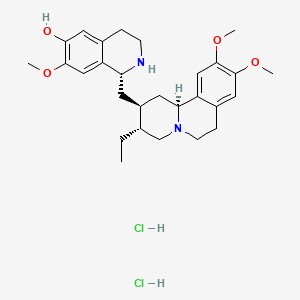
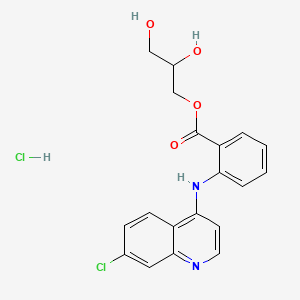
![N-[(4-bromophenyl)methyl]-4-chloro-N-(2-oxoazepan-3-yl)benzenesulfonamide](/img/structure/B1663497.png)
![8-hydroxy-5-[(1R)-1-hydroxy-2-[2-[4-(4-methoxy-3-phenylanilino)phenyl]ethylamino]ethyl]-1H-quinolin-2-one;hydrochloride](/img/structure/B1663498.png)
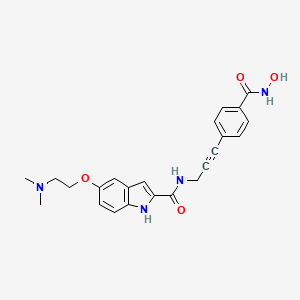



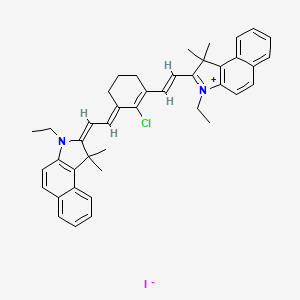
![(E)-[6]-Dehydroparadol](/img/structure/B1663509.png)
